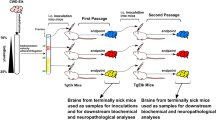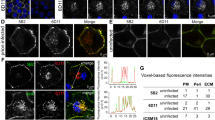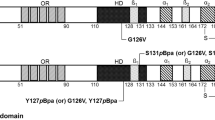Abstract
Mammalian prions cause fatal neurodegenerative conditions including Creutzfeldt–Jakob disease in humans and scrapie and bovine spongiform encephalopathy in animals1. Prion infections are typically associated with remarkably prolonged but highly consistent incubation periods followed by a rapid clinical phase. The relationship between prion propagation, generation of neurotoxic species and clinical onset has remained obscure. Prion incubation periods in experimental animals are known to vary inversely with expression level of cellular prion protein. Here we demonstrate that prion propagation in brain proceeds via two distinct phases: a clinically silent exponential phase not rate-limited by prion protein concentration which rapidly reaches a maximal prion titre, followed by a distinct switch to a plateau phase. The latter determines time to clinical onset in a manner inversely proportional to prion protein concentration. These findings demonstrate an uncoupling of infectivity and toxicity. We suggest that prions themselves are not neurotoxic but catalyse the formation of such species from PrPC. Production of neurotoxic species is triggered when prion propagation saturates, leading to a switch from autocatalytic production of infectivity (phase 1) to a toxic (phase 2) pathway.
This is a preview of subscription content, access via your institution
Access options
Subscribe to this journal
Receive 51 print issues and online access
$199.00 per year
only $3.90 per issue
Buy this article
- Purchase on Springer Link
- Instant access to full article PDF
Prices may be subject to local taxes which are calculated during checkout


Similar content being viewed by others
References
Collinge, J. Prion diseases of humans and animals: their causes and molecular basis. Annu. Rev. Neurosci. 24, 519–550 (2001)
Griffith, J. S. Self-replication and scrapie. Nature 215, 1043–1044 (1967)
Prusiner, S. B. Novel proteinaceous infectious particles cause scrapie. Science 216, 136–144 (1982)
Gajdusek, D. C. Transmissible and non-transmissible amyloidoses: autocatalytic post-translational conversion of host precursor proteins to β- pleated sheet configurations. J. Neuroimmunol. 20, 95–110 (1988)
Come, J. H., Fraser, P. E. & Lansbury, P. T. J. A kinetic model for amyloid formation in the prion diseases: importance of seeding. Proc. Natl Acad. Sci. USA 90, 5959–5963 (1993)
Collinge, J. & Clarke, A. A general model of prion strains and their pathogenicity. Science 318, 930–936 (2007)
Collinge, J. et al. Kuru in the 21st century–an acquired human prion disease with very long incubation periods. Lancet 367, 2068–2074 (2006)
Scott, M. et al. Transgenic mice expressing hamster prion protein produce species- specific scrapie infectivity and amyloid plaques. Cell 59, 847–857 (1989)
Büeler, H. et al. High prion and PrPSc levels but delayed onset of disease in scrapie-inoculated mice heterozygous for a disrupted PrP gene. Mol. Med. 1, 19–30 (1994)
Hill, A. F. et al. Species barrier independent prion replication in apparently resistant species. Proc. Natl Acad. Sci. USA 97, 10248–10253 (2000)
Hill, A. F. & Collinge, J. Subclinical prion infection. Trends Microbiol. 11, 578–584 (2003)
Dickinson, A. G., Meikle, V. M. & Fraser, H. Genetical control of the concentration of ME7 scrapie agent in the brain of mice. J. Comp. Pathol. 79, 15–22 (1969)
Dickinson, A. G. Host-pathogen interactions in scrapie. Genetics 79 (Suppl). 387–395 (1975)
Kimberlin, R. H. & Walker, C. A. Pathogenesis of mouse scrapie: dynamics of agent replication in spleen, spinal cord and brain after infection by different routes. J. Comp. Pathol. 89, 551–562 (1979)
Kimberlin, R. H. & Walker, C. A. Pathogenesis of scrapie (strain 263K) in hamsters infected intracerebrally, intraperitoneally or intraocularly. J. Gen. Virol. 67, 255–263 (1986)
Czub, M., Braig, H. R. & Diringer, H. Pathogenesis of scrapie: study of the temporal development of clinical symptoms, of infectivity titres and scrapie-associated fibrils in brains of hamsters infected intraperitoneally. J. Gen. Virol. 67, 2005–2009 (1986)
Oesch, B. et al. A cellular gene encodes scrapie Prp 27-30 protein. Cell 40, 735–746 (1985)
Klohn, P., Stoltze, L., Flechsig, E., Enari, M. & Weissmann, C. A quantitative, highly sensitive cell-based infectivity assay for mouse scrapie prions. Proc. Natl Acad. Sci. USA 100, 11666–11671 (2003)
Büeler, H. et al. Normal development and behaviour of mice lacking the neuronal cell-surface PrP protein. Nature 356, 577–582 (1992)
Fischer, M. et al. Prion protein (PrP) with amino-proximal deletions restoring susceptibility of PrP knockout mice to scrapie. EMBO J. 15, 1255–1264 (1996)
Büeler, H. et al. Mice devoid of PrP are resistant to scrapie. Cell 73, 1339–1347 (1993)
Dickinson, A. G., Fraser, H., Meikle, V. M. & Outram, G. W. Competition between different scrapie agents in mice. Nat. New Biol. 237, 244–245 (1972)
Safar, J. et al. Eight prion strains PrPSc molecules with different conformations. Nature Med. 4, 1157–1165 (1998)
Cronier, S. et al. Detection and characterization of proteinase K-sensitive disease-related prion protein with thermolysin. Biochem. J. 416, 297–305 (2008)
Li, J., Browning, S., Mahal, S. P., Oelschlegel, A. M. & Weissmann, C. Darwinian evolution of prions in cell culture. Science 327, 869–872 (2010)
Solforosi, L. et al. Cross-linking cellular prion protein triggers neuronal apoptosis in vivo. Science 303, 1514–1516 (2004)
Race, R., Raines, A., Raymond, G. J., Caughey, B. & Chesebro, B. Long-term subclinical carrier state precedes scrapie replication and adaptation in a resistant species: analogies to bovine spongiform encephalopathy and variant Creutzfeldt-Jakob disease in humans. J. Virol. 75, 10106–10112 (2001)
Thackray, A. M., Klein, M. A., Aguzzi, A. & Bujdoso, R. Chronic subclinical prion disease induced by low-dose inoculum. J. Virol. 76, 2510–2517 (2002)
Thackray, A. M., Klein, M. A. & Bujdoso, R. Subclinical prion disease induced by oral inoculation. J. Virol. 77, 7991–7998 (2003)
Asante, E. et al. BSE prions propagate as either variant CJD-like or sporadic CJD-like prion strains in transgenic mice expressing human prion protein. EMBO J. 21, 6358–6366 (2002)
Acknowledgements
This work was funded by the UK Medical Research Council. We thank J. Wadsworth for critical review of the manuscript, S. Walker for statistical advice, staff of our Biological Services Facility for animal care and technical assistance and R. Young for preparation of figures.
Author information
Authors and Affiliations
Contributions
M.K.S., H.A.-D. and B.S. performed the work. M.K.S., A.R.C. and J.C. designed the study and analysed the data. J.C. drafted the manuscript. All authors discussed the results and commented on the manuscript.
Corresponding author
Ethics declarations
Competing interests
The authors declare no competing financial interests.
PowerPoint slides
Rights and permissions
About this article
Cite this article
Sandberg, M., Al-Doujaily, H., Sharps, B. et al. Prion propagation and toxicity in vivo occur in two distinct mechanistic phases. Nature 470, 540–542 (2011). https://doi.org/10.1038/nature09768
Received:
Accepted:
Published:
Issue Date:
DOI: https://doi.org/10.1038/nature09768
This article is cited by
-
Iatrogenic Alzheimer’s disease in recipients of cadaveric pituitary-derived growth hormone
Nature Medicine (2024)
-
Propagation of PrPSc in mice reveals impact of aggregate composition on prion disease pathogenesis
Communications Biology (2023)
-
Prion strains viewed through the lens of cryo-EM
Cell and Tissue Research (2023)
-
Extracellular vesicles with diagnostic and therapeutic potential for prion diseases
Cell and Tissue Research (2023)
-
Mechanisms of prion-induced toxicity
Cell and Tissue Research (2023)
Comments
By submitting a comment you agree to abide by our Terms and Community Guidelines. If you find something abusive or that does not comply with our terms or guidelines please flag it as inappropriate.



